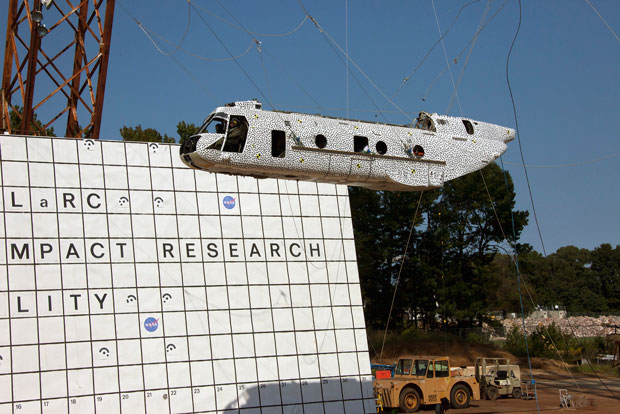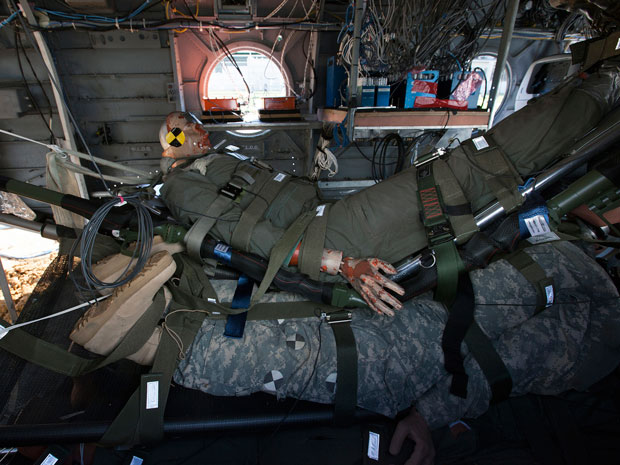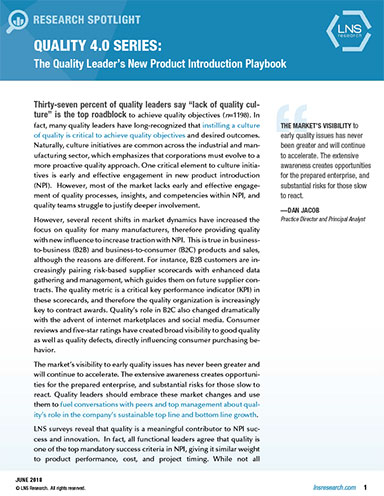Drop Testing Sensors Capture Critical Data

In October 2014, NASA conducted a drop test with a Sea Knight helicopter in Langley, VA. The agency used data recorders from Diversified Technical Systems (DTS) to capture the critical values from the test. Image courtesy of DTS.
Latest News
September 1, 2015
 In October 2014, NASA conducted a drop test with a Sea Knight helicopter in Langley, VA. The agency used data recorders from Diversified Technical Systems (DTS) to capture the critical values from the test. Image courtesy of DTS.
In October 2014, NASA conducted a drop test with a Sea Knight helicopter in Langley, VA. The agency used data recorders from Diversified Technical Systems (DTS) to capture the critical values from the test. Image courtesy of DTS.April 27, 2012, was a clear, balmy day in Mexicali, Mexico—a picture-perfect day for a Boeing 727 to crash-land in the middle of a desert. The crash was intentional. It took four years to arrange the event, captured for a special two-hour episode of Discovery Channel’s “Curiosity TV.” The ill-fated passengers were crash-test dummies worth more than half a million dollars (ABC News, “Good Morning America,” Neal Karlinsky, October 2012).
Last October in Langley, VA by order of NASA, a CH-46E Sea Knight helicopter smashed into the ground at 30 mph from a 30 ft. height. The doomed vehicle carried 13 manikins, whose experiences were captured by the 40 HD cameras onboard snapping away 500 images per second.
These two tests represent the most extreme type of product testing. The cost of the sacrificial plane or helicopter is only a fraction of the expense involved; they take much time and effort to prepare and they have very little room for error. You get one shot at capturing the critical data you need from the event. That gives Diversified Technical Systems (DTS), a sensor and data acquisition system supplier, a lot of bragging rights. The manikins on the 727 and Sea Knight were wired up with hundreds of sensors and DTS data recorders. Their final moments were preserved as loads, stresses, acceleration and displacement values for posterity, even if some of them didn’t survive the impact in one piece.
Protecting the Data Recorder
Large-scale destructive tests like the 727 crash in Mexicali and the helicopter drop in Langley are usually the final verification to determine if the vehicle’s structure would hold up during impact, and whether the human passengers onboard could walk away from such a catastrophic event with superficial wounds or suffer fatal injuries. Damage to the test vehicle is expected, but the extent of the damage becomes clear after the experiment.
While the survivability of the test object is undetermined, the survivability of the data recorders must be ensured. Otherwise, all the critical data the test is designed to capture will be lost in a pile of shattered instruments. “In a test like [the helicopter drop], the data-acquisition systems are going to take quite a beating. Most won’t survive the shock of the impact. Our recorders are tested to survive 500 g shock. If the shock anticipated is even greater, we can refine our equipment to make sure it survives,” says Hans Hellsund, director of Sales and Marketing at DTS.
DTS uses a shock machine and a drop tower at its facility to test the survivability of its own data recording systems. “We test our products to survive 500 g in every axis before it goes out the door,” says Hellsund. Some DTS products have been used to record the impact behaviors of missiles. NASA has been using DTS data acquisition systems for the past 15 years, according to the company.
In the Sea Knight helicopter drop test, NASA uses DTS’ TDAS G5 module, which is smaller than a deck of cards. The SLICE NANO version is as small as a box of mints, just a quarter of the size of the other module. “We use durable components, shock-isolation mounts to make sure things don’t rattle around during impact, and anodized aluminum for enclosure,” Hellsund says.
For a plane crash or helicopter drop, the added weight from the data acquisition systems and sensors is not significant enough to make a difference, but for other scenarios involving lighter products (like a bicycle), it might. In such experiments, the compactness of sensor equipment offers an advantage. “Our products are so small they won’t create a mass-loading effect that changes the dynamics of the experiment,” says Hellsund.
The Anxious Moment
Setting up a digital crash simulation requires a few hours of labor from an expert proficient in the simulation software. Setting up a real-world crash experiment, however, requires much more. “In a typical vehicle test, it takes one to seven days just to prep the car,” says Shelly Horvath, marketing specialist at DTS.
Hellsund explains that in a typical experiment involving a vehicle or an aerial craft, the client uses accelerometers, load cells, pressure sensors and potentiometers to understand how the craft behaves during descent and what forces the manikins are subjected to.
 The manikin representing a real passenger in the drop test is wired with DTS data recorders that can withstand up to 500g shock. Image courtesy of DTS.
The manikin representing a real passenger in the drop test is wired with DTS data recorders that can withstand up to 500g shock. Image courtesy of DTS.“These experiments are expensive, so everyone is usually gnashing their teeth, double-checking and triple-checking everything before the drop happens,” says Hellsund. Because of the cost involved in physical testing, many manufacturers now rely on digital simulation whenever possible. While software-based simulation makes it possible to reduce the number of real-world tests, it doesn’t eliminate them altogether.
Drop Tests in Pixels
While the variation of drop tests and crash tests is almost infinite, the mechanism and the physics involved are fairly similar across the board. At its core, the test is designed to simulate a specific mass hitting a hard surface at a certain speed. It is one of the repeatable scenarios software developers hope to address using a module, a plug-in, or a standalone product.
SolidWorks Simulation Professional, a package tightly integrated with Dassault Systèmes’ SolidWorks CAD program, includes a drop test simulation function. (Those with regular licenses of SolidWorks Simulation may need to pay an additional fee to access the module.) “We packaged a non-linear dynamic problem that was traditionally very complex into a simple, easy-to-use study type. Setting up the problem is as simple as saying, here’s my geometry, here’s my floor, here’s the distance between them, now let me see the results,” says Stephen Endersby, product manager at SolidWorks Simulation.
In the consumer goods industry, the cellphone is a good candidate for virtual drop tests. It’s prone to drops. It’s made of delicate electronics and a display that can shatter. But you may also perform drop tests involving other products (for instance, laptops and desktop computers) using SolidWorks Simulation Professional, says Endersby. “You should start with a simple model with just a few loads,” he says. “Then if the results look right, you build more complexity into it. You shouldn’t try to eat an elephant in one bite.”
The function, however, may not be suitable for scenarios involving complex geometry deformation from impact that requires secondary meshing during the process. In cases like a helicopter’s drop or even a plastic bottle crush, the metal twisting and plastic crumpling behavior may require additional meshing to produce accurate results. Such simulations may be outside the range manageable by SolidWorks Simulation’s drop test study. “That’s where you’re no longer looking at a simple a drop, but a crash with extreme deformation and a high rate of change,” Endersby says.
The drop test simulation is “very computation intensive,” Endersby says; therefore, developers are looking into supporting clusters in the future. The current version of the solver runs only on a local computer. It’s programmed to take advantage of multicore CPUs during meshing and solving. GPU (graphics processing unit) acceleration is not yet supported.
Drop Testing on High-Performance Computing
In September of 2014, Dell, Intel and simulation software supplier Altair collaborated to digitally simulate a cellphone drop test (“HPC Gets the Drop on Design Simulation” podcast, Inside HPC, September 2014). The project employed 16 Dell PowerEdge HPC Blade servers equipped with Intel Xeon E5-2600 v2 CPUs, running Altair’s HyperWorks RADIOSS software. The outcome of the joint study is a benchmark on virtual drop testing titled
Subscribe to our FREE magazine, FREE email newsletters or both!
Latest News
About the Author
Kenneth Wong is Digital Engineering’s resident blogger and senior editor. Email him at kennethwong@digitaleng.news or share your thoughts on this article at digitaleng.news/facebook.
Follow DERelated Topics





